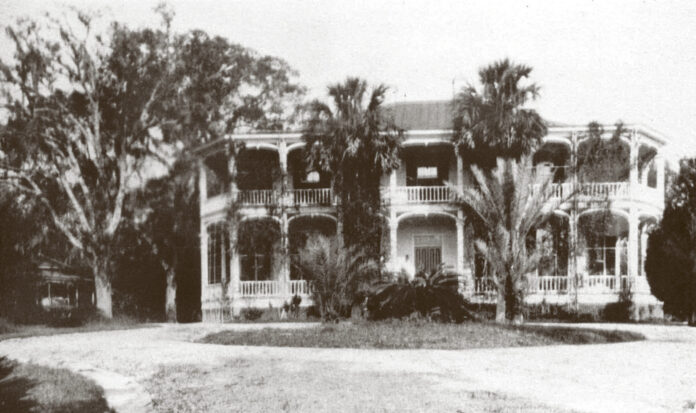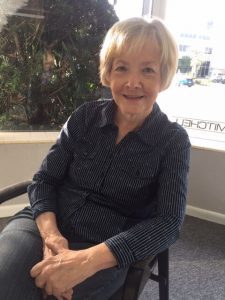
54 YEARS YOUNG — Now 151 years old, DeBary Hall is shown here in about 1925, when it was about 54 years old. The historic site is open to the public 10 a.m.-4 p.m. Tuesday through Saturday, and noon-4 p.m. on Sundays, with 3:30 p.m. the cutoff time for tours of the mansion. The site is listed on the National Register of Historic Places.
A newcomer arrived in West Volusia from New York City in 1868.

Samuel Frederick DeBary was born in Germany to a family of Belgian ancestry. In 1840, at the age of 25, DeBary had been sent to New York City as the sole distributor for the Mumms Champagne Co., one of the top-ranked global marketers of the day.
DeBary was selling to what was then the virgin market of the newly wealthy class of merchants, manufacturers, and financiers residing in New York. Because luxury items were not yet mass-produced in the U.S., one’s social prestige was often measured by one’s consumption of European luxury items.
DeBary, therefore, was able to develop a flourishing import-business empire.
Although DeBary was not a true aristocrat, he soon became prominent in wealthy New York society and, by the late 1860s, was already a millionaire, living on Fifth Avenue among his socially prominent neighbors, including the Vanderbilts and the Astors. He was well able to enjoy the fruits of his work, and one of his favorite pastimes was to travel around the country in pursuit of his sportsman hobbies.
Even before the Civil War, DeBary was a winter visitor and patron of the Brock House in Enterprise. He was drawn to Florida by advertisements for the hotel that were featured in the many popular hunting and fishing guidebooks of the day.
During one visit, DeBary purchased a 400-acre parcel with a large sugar plantation, a gristmill and an orange grove, near the north shore of Lake Monroe. A vegetable farm, dairy herd, and wild game preserve were soon added, and a freshwater spring on the property was tapped, making DeBary’s holdings entirely self-sufficient.
In 1871, DeBary started to build what would be his property’s crowning glory: a 20-room, Italianatestyle “hunting lodge” that he named DeBary Hall. Situated in an oak grove on the high point of the property, approximately 1 mile from the lake, it was the most luxurious dwelling the area had ever seen.
The seven-bedroom, two-story mansion, with wraparound verandas on both levels, was carefully designed for lavish entertaining.
It had a large center hall and 15-foot-high, floor-to-ceiling windows. There were fireplaces in every room, and in the kitchen there was a massive iron stove and three iceboxes of nearly walk-in proportions.
More amenities were soon added, such as stables, an icehouse, and a spring-fed swimming pool, probably the first one in Volusia County.
The hall served as an annual winter retreat for DeBary and his family and the large number of visitors he invited to join him during the mild Florida winters. Among his guests were notable people from all over Europe and the Americas.
The wild hunt
The most elaborate activities DeBary provided for these prominent visitors involved forays into the great outdoors. While the fishing parties along the St. Johns River or over into New Smyrna Beach for surf casting were certain to impress, DeBary’s most-celebrated entertainments were the hunting excursions that took guests into the thickly forested neighborhoods of what today are the cities of DeBary and Deltona.

GUNS — Long guns stacked on the lawn of DeBary Hall for a Civil War re-enactment may be reminiscent of the rifles used in Frederick DeBary’s wild hunts.
In 1945, an elderly Black servant who had worked in his youth as groundskeeper at DeBary Hall, provided a first-person account of these expeditions.
He reported that DeBary left little to chance to ensure that each hunter would be able to bag at least a few birds.
Throughout the year, the field vegetation was carefully trimmed and corn and millet grain were spread to ensure that an abundance of doves and bobwhite quail would take up residence.
A full staff of feeders and keepers were expertly trained for their tasks. Just before the hunt, extra quail from DeBary’s own special reserve were released into the fields.
Some have noted that it took a certain kind of flamboyance for DeBary to turn acres of woodlands into a sanctuary for doomed birds.
The former groundskeeper went on to describe the special routines that occurred when the day of the big event arrived.
A sumptuous breakfast was set out at 4:30 in the morning to give the members of the party time to dress up in their most fashionable hunting clothes for a sunrise departure. DeBary’s stable and kennel provided ample mounts and packs of hounds for the hunters.
Nonhunting guests were taken out in a horse and buggy, and were served coffee, tea and biscuits while the others stalked their prey.
A number of servants called “beaters” were assigned to walk ahead of the hunters to drive the birds out of the bushes.
On one occasion, when the young groundskeeper was performing this task, a stray pellet from one of the hunter’s shotguns hit him in his left eye. The shooter apologized and paid the wounded man $3, an uncommonly generous recompense for a Black servant in that day.
At the scene, the injury was deemed minor, and the young man continued the hunt with only a slight blurring of vision that was expected to clear up shortly. Unfortunately, his condition worsened in the days following the accident, and ultimately resulted in his losing all sight in the eye.
A large hamper full of food was always set in among the guns and gear on the muledrawn supply wagons, because the shooting forays lasted well into the afternoon.
After serving lunch in the fields, the servants packed up all the remains of the expedition, including the hunting bounty, and transported everyone back to DeBary Hall to rest.
After a good nap, guests would take a swim in the spring-fed pool or stroll the grounds and botanical gardens until dinner — a grand feast designed to cap off the day in high style.
At DeBary’s enormous dining table, all the fresh game from the day’s hunt was spread among multitudes of other fancy Continental-inspired dishes, and the Mumms products flowed profusely. Most of the diners did not make it to their plush beds until dawn.
Competition becomes fierce
In his later years, the rich foods and wines DeBary indulged in left him corpulent and gout-ridden, and a hand-operated elevator had to be installed in DeBary Hall to transport him up and down the stairs; yet, in his prime, DeBary had ambitious plans for himself and was far from being just an idle, wealthy playboy.
During his Florida visits, DeBary turned his Florida holdings into a highly profitable venue. Over time, he acquired an additional 9,000 acres, where he planted orange groves and pecan trees.

WELL-PRESERVED — DeBary Hall, at 198 Sunrise Blvd. in DeBary, is now owned and operated by Volusia County as a historic site. It’s now the scene of community events and activities open to all, unlike the private parties for the ultrarich that were hosted there by its builder, Frederick DeBary, a champagne merchant from New York.
An astute businessman, DeBary developed some major innovative practices in the citrus industry. For example, his packinghouse beside Lake Monroe was one of the first to sort oranges by feeding the crop down a gutter lined with various-sized holes.
DeBary crowned his achievements by founding his own steamboat line on the St. Johns River, where at first he had commissioned boats solely for his private use.
However, locals soon began paying him to transport them, along with the dogs and horses he was carrying, up and down the river for hunting expeditions.
By the 1870s, when Florida’s tourist trade was doubling each year, DeBary began carrying winter visitors from the North, as well. Because he realized the potential of these trends, DeBary decided to expand his private steamer line into commercial usage. The competition for steamboat tourist customers was about to become fierce.
Jacob Brock’s line of steamers was already well-established and highly profitable when DeBary was just getting started.
In 1870, when dentist H.D. Bracy brought his family to Beresford, there were only two boats on the St. Johns — the Darlington and the Hattie, both of the Brock line.
However, DeBary spared no expense in his attempt to make his business competitive.
He added staterooms on the upper decks and other accommodations to win more travelers. Very soon, DeBary was running neck and neck with Brock in vying for his portion of the Florida tourism dollar.
Due in no small part to the transportation convenience that the Brock/DeBary competition brought to the St. Johns steamboat service, a steady influx of permanent settlers arrived in the surrounding lands.
— Ryder and her husband, Bob Wetton, live in DeLand and are active members of the West Volusia Historical Society. For information about obtaining a copy of her book Better Country Beyond, call the Historical Society at 386-740-6813, or email delandhouse@msn.com. All proceeds from the sale of this book go to the West Volusia Historical Society’s Bill Dreggors Fund, which helps finance the printing of books about West Volusia history.